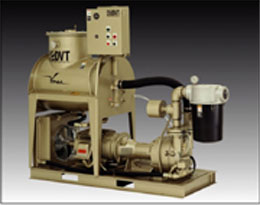What is vacuum forming?
Vacuum forming, a simpler form of thermoforming, requires rapid evacuation to a deep vacuum while the plastic sheeting is still hot. The vacuum pumps pulls a hot sheet against a single-surface mold. The hot sheet takes the shape of the mold as the vacuum pump pull deeper vacuum. Once formed, a drill, roll cutter, or CNC machine separates individual products.
This process must happen quickly in order to ensure the plastic does not cool off. Too slow of a pull down will result in improper corner formation as the plastic cools and hardens. To keep the equipment costs to a minimum, this is accomplished by using a vacuum balancing tank with automatic valves and a properly sized vacuum system, based on cycle times.
Who uses vacuum forming?
Vacuum forming is common in OEMs who produce identical components in the 250-3000 units per year range. The thermoformed plastics substitute some more expensive and complicated materials to fabricate. For example, these components replace sheet metal, fiberglass, or plastic injection molding. Car part manufacturers often use this process for replacement parts. Packaging suppliers also use vacuum forming to secure products with a formed plastic.
How Wintek designs for forming applications
Wintek has supplied many systems on thermoforming, both dedicated vacuum pumps and central vacuum systems. The most common type of pump is typically a rotary vane pump. This type of pump achieves deep vacuum levels and is good for handling dry air. If any solvents pass through the molds, Wintek recommends using an oil-sealed liquid ring vacuum pump. Although the oil may periodically need to be changed, these pumps handle small amounts of process carryover and achieve much deeper vacuum levels that water-sealed liquid ring pumps due to the lower vapor pressure of the oil sealant.

